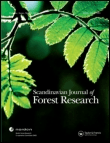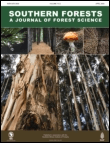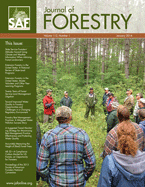
SCANDINAVIAN JOURNAL OF FOREST RESEARCH
Scope & Guideline
Unveiling the Secrets of Forest Resilience and Sustainability
Introduction
Aims and Scopes
- Forest Ecology and Management:
Research focused on understanding forest ecosystems, their dynamics, and management practices that promote sustainability while considering biodiversity. - Forest Economics and Policy:
Studies examining the economic aspects of forestry, including cost-benefit analyses of management practices, market dynamics, and the socio-political factors influencing forest policy. - Forest Health and Protection:
Exploration of forest pests, diseases, and the impacts of environmental stressors on forest health, aiming to develop effective management strategies. - Climate Change and Adaptation:
Research on the impacts of climate change on forest ecosystems and the development of adaptive management strategies to mitigate these effects. - Bioeconomy and Resource Utilization:
Investigations into the sustainable use of forest resources, including biomass production, carbon sequestration, and the role of forests in the bioeconomy. - Technological Advances in Forestry:
Application of new technologies, such as remote sensing and modeling, to enhance forest management practices and data collection.
Trending and Emerging
- Climate Change Impacts and Adaptation:
There is a rising focus on understanding how climate change affects forest ecosystems and developing adaptive strategies for forest management to enhance resilience. - Forest Biodiversity and Conservation:
Increased attention on the importance of maintaining biodiversity within forest ecosystems, including studies on habitat loss, species interactions, and conservation strategies. - Integration of Technology in Forestry:
Emerging research is increasingly utilizing advanced technologies such as remote sensing, UAVs, and machine learning to improve forest monitoring and management. - Forest-Based Bioeconomy:
A growing emphasis on the role of forests in the bioeconomy, including sustainable resource utilization, carbon markets, and the socio-economic impacts of forestry. - Socio-Economic Aspects of Forestry:
Research is expanding into the social dimensions of forestry, exploring stakeholder perceptions, community engagement, and the socio-political context of forest management.
Declining or Waning
- Traditional Silvicultural Practices:
Research focusing on conventional silvicultural methods is becoming less prevalent as emphasis shifts towards more innovative and sustainable practices. - Species-Specific Studies:
There is a decreasing trend in studies that center solely on specific tree species without considering broader ecosystem interactions and management implications. - Historical Forest Management Practices:
Papers concentrating on historical practices are less common, indicating a move towards contemporary challenges and future-oriented forestry research. - Stand-Level Management Approaches:
The focus on stand-level management is waning in favor of landscape-level and ecosystem-based approaches that consider multiple interacting factors.
Similar Journals

BALTIC FORESTRY
Advancing Sustainable Solutions in ForestryBALTIC FORESTRY, published by the INST FORESTRY LRCAF in Lithuania, is a prominent academic journal that serves as a platform for disseminating cutting-edge research in the field of forestry. With an ISSN of 1392-1355, this journal is dedicated to advancing knowledge on sustainable forest management, ecological impacts, and resource conservation, among other vital topics. As of 2023, it has been categorized in the Q3 quartile for forestry in Scopus, indicating its solid reputation among peer-reviewed publications, ranking #95 out of 174 in the realm of Agricultural and Biological Sciences. BALTIC FORESTRY features contributions from researchers across the globe and encourages innovative approaches to solving contemporary challenges in forestry, making it an essential resource for professionals, scholars, and students alike. Although it operates under subscription-based access options, the journal's commitment to fostering academic discourse is unwavering, aiming to bridge the gap between theory and practice in forest science.

Revista Forestal Mesoamerica Kuru-RFMK
Fostering collaboration for forest health and biodiversity.Revista Forestal Mesoamerica Kuru-RFMK is a vital academic platform dedicated to the advancement of forest science and management within the Mesoamerican region. Published by the Instituto Tecnológico de Costa Rica, this journal has been an Open Access resource since 2011, ensuring that critical research is accessible to a global audience. With an ISSN of 2215-2504, it aims to foster collaboration and knowledge exchange among researchers, professionals, and students eager to address the pressing challenges facing forests in Central America. The journal prioritizes interdisciplinary studies related to forest ecology, conservation, and sustainable management practices, making it an indispensable reference for anyone interested in enhancing forest health and biodiversity. By contributing to this resource, scholars can impact policy and practice while enriching the academic community’s understanding of Mesoamerica's unique forest ecosystems.

Madera y Bosques
Unveiling the Complexities of Forest ManagementMadera y Bosques is a prominent academic journal specializing in the fields of forestry and wood science, published by INST ECOLOGIA A C in Mexico. With an ISSN of 1405-0471 and an E-ISSN of 2448-7597, it has established itself as a vital platform for disseminating research findings, innovative practices, and methodologies pertinent to sustainable forest management and ecological conservation. Operating since 2008, the journal covers a wide scope of topics related to the complexities of forest ecosystems, the importance of biodiversity, and the challenges posed by climate change. Despite its categorization in Q4 for the year 2023 in the Forestry category, Madera y Bosques aims to elevate discourse and practice in the field, providing a voice to emerging researchers and seasoned professionals alike. Additionally, the journal adheres to open access principles, enhancing the visibility and accessibility of its articles to a global audience. Researchers and practitioners are encouraged to engage with its rich content to further their understanding and impact in the world of forestry.

Central European Forestry Journal
Exploring the depths of Central European forestry science.Central European Forestry Journal, published by SCIENDO, is a pivotal platform dedicated to advancing research and knowledge in the field of forestry. Since its inception in 2009, this Open Access journal has provided scholars and practitioners with unrestricted access to cutting-edge research findings, promoting collaboration and innovation within the forestry community. Based in Poland, the journal serves as a crucial resource for researchers, professionals, and students alike, addressing critical topics relevant to the management, conservation, and sustainable utilization of forest resources. The journal holds a commendable Q2 ranking in Forestry, with a notable rank of 51 out of 174 and a 70th percentile in Scopus's Agricultural and Biological Sciences category. With converged publication from 2017 to 2024, the Central European Forestry Journal represents an essential avenue for disseminating knowledge and fostering dialogue in an increasingly important field.

Forests
Championing open access to vital forestry knowledge.Forests is a premier open-access journal published by MDPI, dedicated to advancing research in the field of forestry and its related disciplines. Established in 2010, the journal has rapidly gained recognition, achieving a distinguished Q1 ranking in Forestry and holding a commendable position of 38 out of 174 in the Agricultural and Biological Sciences category within Scopus, placing it in the 78th percentile. With a mission to disseminate high-quality research, Forests serves as a vital platform for the exchange of innovative findings, methodologies, and applications related to forest ecosystems, management, conservation, and the socio-economic aspects of forestry practices. As an open-access publication based in Switzerland, it ensures that research is readily accessible to a global audience, fostering collaboration and knowledge sharing among researchers, professionals, and students alike. The journal is committed to contributing to the sustainable management of forest resources and enhancing the understanding of complex forest environments through interdisciplinary approaches.

ANNALS OF FOREST SCIENCE
Transforming Understanding of Forest EcosystemsANNALS OF FOREST SCIENCE, published by Springer France, stands at the forefront of ecological research, contributing significantly to both the fields of Ecology and Forestry, as evidenced by its prestigious Q1 ranking in both categories for 2023. Since its inception in 1999, this journal has become an essential resource for academics, practitioners, and students who are eager to explore the complexities of forest ecosystems and their interactions with global environmental changes. With an ISSN of 1286-4560 and E-ISSN 1297-966X, it disseminates cutting-edge research and critical reviews that enhance our understanding of forest science. Although it does not offer open access, the journal continues to be a pivotal platform for presenting innovative scientific findings that address the pressing challenges of forest management and conservation. Its significant impact factor reflects the high-quality contributions that have made a lasting mark on the discipline.

Sylwan
Connecting science and practice in sustainable forest management.Sylwan, published by POLSKIE TOWARZYSTWO LESNE, is a key journal in the field of forestry, focusing on the science and practice of sustainable forest management and conservation. Operating since 1979 and releasing issues periodically, including those from 2011 to 2018 and from 2020 to 2024, this journal plays a vital role in disseminating research and advances in forestry practices particularly relevant to Poland and the broader European context. While currently not offering open access options, Sylwan maintains a Q4 ranking in the forestry category according to the Scopus database, highlighting its dedicated niche within the scientific community. The journal serves as an essential resource for researchers, professionals, and students seeking to enhance their understanding of forestry issues in a global and ecological framework. With a commitment to promoting innovative research, Sylwan supports the ongoing dialogue on forestry management and policies, ultimately contributing to the sustainable development of forest resources.

SEEFOR-South-East European Forestry
Connecting research, policy, and practice for a greener future.SEEFOR-South-East European Forestry is a premier open-access journal dedicated to advancing knowledge in the field of forestry and environmental science. Published by the CROATIAN FOREST RESEARCH INSTITUTE, this journal has been operational since 2010, providing a platform for research that focuses on the unique forestry dynamics of the South-East European region. With an ISSN of 1847-6481 and an E-ISSN of 1849-0891, SEEFOR is recognized for its commitment to disseminating high-quality research that addresses critical issues in forestry management, conservation, and sustainable development. The journal is indexed in Scopus, placing it within the third quartile (Q3) of forestry journals, reflecting its significance within the academic community. SEEFOR aims to connect researchers, practitioners, and policymakers, fostering collaboration and innovation in fostering sustainable forestry practices in Croatia and beyond. Submissions are welcome in a range of areas including forest ecology, policy development, and socio-economic impacts, making it an invaluable resource for professionals and students alike.

Southern Forests-A Journal of Forest Science
Shaping the Future of Forestry Through Scholarly InsightSouthern Forests: A Journal of Forest Science, published by Taylor & Francis Ltd, serves as a vital platform for scholarly discourse in the field of forestry. With a robust ISSN of 2070-2620 and E-ISSN of 2070-2639, this journal highlights cutting-edge research and vital advancements from 2008 to 2024. Based in the United Kingdom, it continues to make significant contributions, evidenced by its current Q3 ranking in the forestry category of Scopus as well as its rank of 94 out of 174 in Agricultural and Biological Sciences. This journal caters to a diverse audience of researchers, professionals, and students, providing access to high-quality articles that promote sustainable forest management and ecological studies. Despite being classified as a non-open access journal, it remains a key resource, ensuring accessibility to crucial information that addresses both local and global forest challenges.

JOURNAL OF FORESTRY
Pioneering insights into forest ecosystems and conservation.JOURNAL OF FORESTRY, published by OXFORD UNIV PRESS INC, is a premier academic journal dedicated to advancing the field of forestry and plant sciences. With a distinguished history dating back to 1919, the journal has evolved to address contemporary challenges and innovations in these critical domains of environmental science. As evidenced by its impressive Q1 rankings in both Forestry and Plant Science categories for 2023, the journal is recognized for its contribution to scholarly research, occupying a significant position among its peers with a Scopus rank of #33 in Forestry and #122 in Plant Science. Researchers and practitioners can access the journal’s articles to stay updated on cutting-edge research, methodologies, and practices that influence sustainable forest management and conservation efforts. By fostering interdisciplinary collaboration, the JOURNAL OF FORESTRY plays a pivotal role in shaping the discourse surrounding forest ecosystems, promoting the integration of science with practice, and facilitating knowledge transfer in academia and industry. As a vital resource for researchers, professionals, and students alike, this journal serves as an essential platform for disseminating high-quality research that addresses pressing environmental concerns.